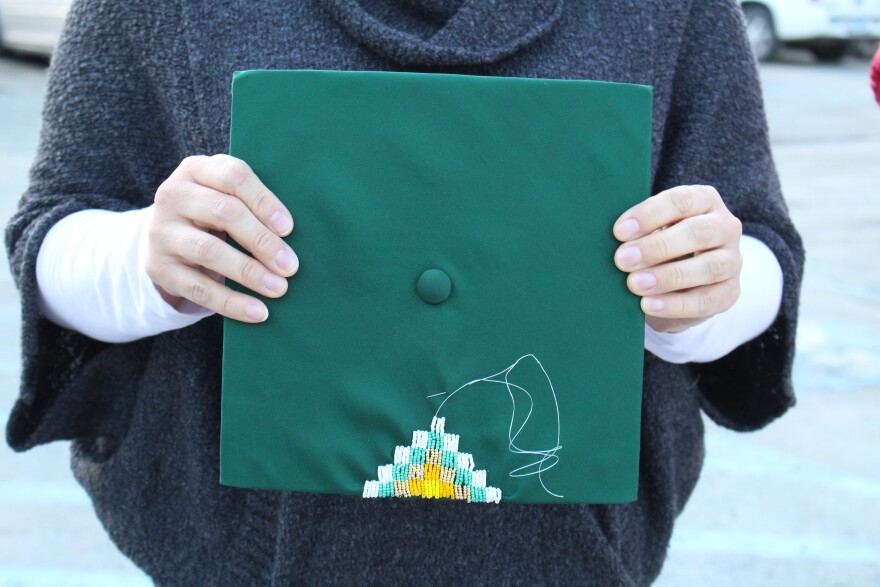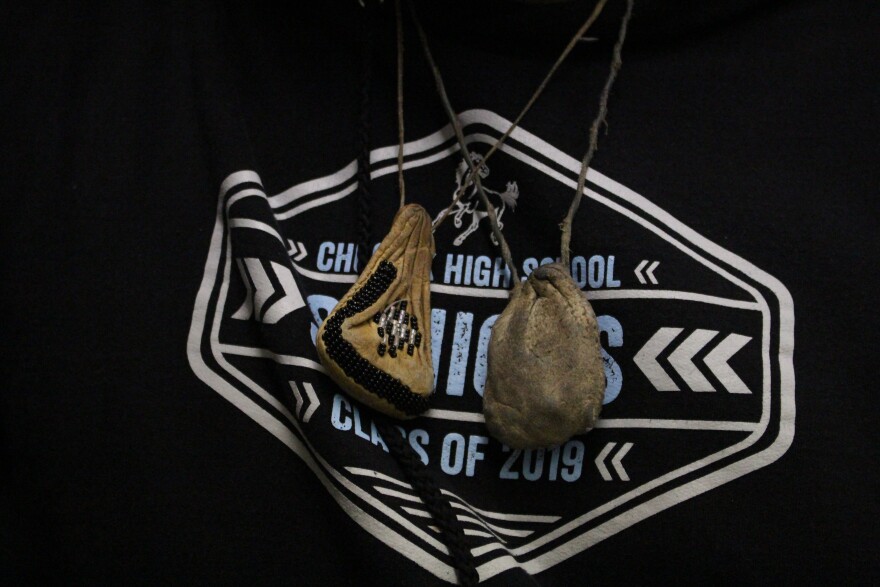Kenneth Huffer always knew his family was Native American. But the blond-haired, blue-eyed Chugiak High School senior says the first time he truly felt Native was three summers ago. That's when he traveled with his dad to the Blackfoot Native American Reservation in Montana where he participated in a traditional okan, or sun dance ceremony.
"It was life changing, how I felt there," Huffer said. "I've never met my grandma. It's like I met her, spiritually, or something like that. I had that connection to the culture. I had that deep passion to learn it, know who I am."
Since the okan, Huffer became dedicated to his Blackfoot roots. He keeps in close contact with a spiritual advisor in Montana and says he wears a medicine pouch and buffalo stone necklace every day to show pride in his heritage.
"Yeah, I made a vow to go back every summer to learn more and keep our traditions, our religion and all that alive," Huffer said.
At a school board meeting this year, Huffer learned that there was a growing student movement to allow Native cultural regalia at high school graduations.
The district dress code required wearing a graduation cap and gown. Individual schools and principals could approve additional attire, but there was no district-wide standard.
His friend Charitie Ropati, a senior at Service High School, testified in her regalia in an effort to get the district to change its rules.
Ropati says representing her heritage — which is Yup'ik, Samoan and Mexican — is powerful.
"We live on stolen land, and that's something a lot of people don't like to admit but it's something that people need to acknowledge," Ropati said. "And so, when it comes to graduation, Native students should have a right to wear their regalia."
Ropati's mother, Elizabeth Lozano, regularly takes her to her home village of Kongiganak to teach her about the language, culture and customs of her people.
"The way Natives represent when there's great success is to wear your regalia," Lozano said.
For Ropati, a high school graduation counts as such a success.
The district recently adopted a new policy that would allow students to decorate their caps and gowns to represent their individual cultures. Doreen Brown is the senior director of Title VI Indian Education with the Anchorage School District. She says, while the push was made by Native students, the policy is broad enough to include other cultures.
"We are the most diverse district in the nation," Brown said. "We have so many kids from all over with all kinds of cultural connections and I think it's time for them to be able to wear and adorn their graduation cap and/or gown in a way that's significant for their family."
Brown says students who are interested in wearing regalia have to fill out a form with the district, listing the objects they plan to wear and the cultural significance. Brown says the purpose of the form is to ensure a safe, respectful ceremony. In the past, students have attempted to wear items showing the Confederate flag and other offensive symbols, under the guise of cultural heritage.
The district still requires that students wear a cap and gown at graduation. Ropati thinks the new policy is a step in the right direction, but she wishes the district allowed for more traditional regalia, like her ceremonial headdress. She says she wants her graduation attire to serve as an example to other Native students.
"One thing about graduation is Native students continue to have the lowest graduation rates and the highest dropout rates when compared to any other demographic," Ropati said. "And so when I graduate high school, I want to make sure people know that I'm Native."
Ropati will adorn her cap with Yup'ik beadwork and wear a traditional beaded necklace and earrings to the ceremony, where she'll be her class graduation speaker. Kenneth Huffer, from Chugiak, is also beading his cap and plans to wear the two necklaces he wears every day, an eagle feather on his tassel and the moccasins he made himself.





